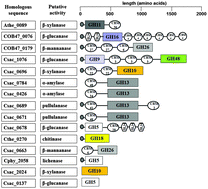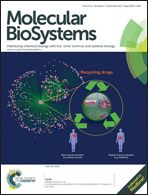Depiction of carbohydrate-active enzyme diversity in Caldicellulosiruptor sp. F32 at the genome level reveals insights into distinct polysaccharide degradation features
Abstract
Thermophilic bacterium Caldicellulosiruptor sp. F32 can utilize cellulose-, hemicellulose-containing biomass, including unpretreated wheat straw. We have conducted a bioinformatics analysis of the carbohydrate-active enzyme (CAZyme) in the genome of Caldicellulosiruptor sp. F32, which reveals a broad substrate range of the strain. Among 2285 predicted open reading frames (ORFs), 73 (3.2%) CAZyme encoding genes, including 44 glycoside hydrolases (GHs) distributing in 22 GH families, 6 carbohydrate esterases (CEs), 3 polysaccharide lyases (PLs), 21 glycosyl transferases (GTs), and 25 carbohydrate-binding modules (CBMs) were found. An in-depth bioinformatics analysis of CAZyme families that target cellulose, hemicellulose, chitin, pectin, starch, and β-1,3-1,4-glucan degradation were performed to highlight specialized polysaccharide degrading abilities of strain F32. A great number of orthologous multimodular CAZymes of Caldicellulosiruptor sp. F32 were found in other strains of genus Caldicellulosiruptor. While, a portion of the CAZymes of Caldicellulosiruptor sp. F32 showed sequence identity with proteins from strains of genus Clostridium. A thermostable β-glucosidase BlgA synergistically facilitated the enzymatic degradation of Avicel by endo-1,4-β-glucanase CelB, which indicated that the synchronous action of synergism between CAZymes enhanced the lignocellulose degradation by Caldicellulosiruptor sp. F32.


 Please wait while we load your content...
Please wait while we load your content...